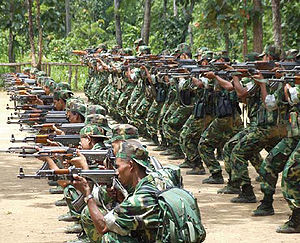Peace Accords Not an Answer to N-E Insurgency
INSURGENCY IS ON A RISE IN NORTH-EAST INDIA

NEW DELHI: Blasts and explosions, death and destruction is not new to the north-east states, particularly Assam, Manipur and Meghalaya. Infact, insurgency is on a continual rise in all the north-east states, barring Sikkim. Only yesterday evening, a bomb blast in Assam’s Kokrajhar district injured at least three. A day before a powerful IED blast in Manipur’s capital city Imphal killed three and wounded four others. The same day, a low intensity explosion was triggered in Bongaigaon district in Assam as well. A week earlier, another strong blast happened in Imphal, in Assam and the list doesn’t seem to end.
While in Manipur migrants are being targeted, in other states the locals have to bear the brunt. Although, no insurgent groups have yet taken the responsibility of the recent blasts in Assam and Manipur; it’s only commonsensical to know.
Another crucial development in this quarter of rising militancy and attempts to combat it is the recent “peace pacts” in Meghalaya. On December 15 this year, A’chik National Volunteers Council (ANVC) and its breakaway faction ANVC–B formally disbanded in an event at Garo Hills.
A “peace agreement” was signed with the Meghalaya government in presence of 748 cadres (from both the factions). Addressing the crowd at that event, the Chief Minister Mukul Sangma used flowery and friendly language and went on to say “It takes exemplary courage to be a part of the mainstream. It demonstrates that violence can never be a solution to any problem. We have reasons to believe that the period of violence will stop with this historic day.”
History is a witness to many of such disbanding ceremonies in these states. What is important to note is the fact that insurgency has rooted from ethnic lines in most states, except Sikkim, demanding either a separate land for their community or breaking away from the country itself. So, if one group disbands or there is a peace pact with one organisation, there might be tens of other rebel groups cropping up asking for the same demands and resorting to similar tactics.
Engagement with the mainstream via peace accords and policies have been occurring for decades and years without solving the real purpose. Interestingly, it appears that once the leaders from the rebel group come to power, they forget the issue they were fighting for. Tapas De, a noted intellectual and former MLA from Tripura as quoted in an article in Tehelka proves my point.“If you look at the recent history of conflict in the Northeast, you will find several examples of this. In Tripura, the Tripura National Volunteers (TNV) signed a peace accord with Rajiv Gandhi when he was the prime minister. The leader of the group, Bijoy Hrankhawal, then became a politician. Take Bodoland for instance. When the Bodo Liberation Tigers (BLT) decided to join the mainstream, during the previous NDA regime under Atal Bihari Vajpayee, a Bodoland Accord was signed. After that BLT leader Hagrama Mohilary formed a political party, the Bodoland Peoples’ Front, and came to power in the local territorial council but Bodoland still remains a hotbed of insurgency and turmoil”, he said.
This unfulfillment of demands, in turn, paves way for other insurgent groups resorting to violence for the same demands and concerns that the earlier group was fighting for. It is a vicious circle of perpetuating violence and bloodshed with a group’s peace pact with the government rather becoming a breeding ground for other groups (with similar demands) to surface.
Further, there are other existing powerful militant groups in the region waging war against the state by making the civilians their victims- be it GNLA in Garo Hills or NDFB or ULFA in Assam.
Peace agreements haven’t lured many of the militant groups. Interestingly, currents members of militant groups get Rs 3,000 each per month as stipend during the time peace talks are underway. But it seems even this doesn’t seem to be working.
It is highly unlikely that these peace accords, in its present state and color, will prove to be of much use to end militancy in the North-east regions. Perhaps, this is the reason the government of India is “seriously examining” the policy for dealing with militants in North East region with a possibility of shift in existing policy soon.



